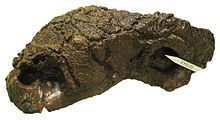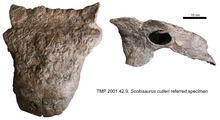スコロサウルス
表示
| スコロサウルス Scolosaurus | ||||||||||||||||||||||||||||||||||||||||||
|---|---|---|---|---|---|---|---|---|---|---|---|---|---|---|---|---|---|---|---|---|---|---|---|---|---|---|---|---|---|---|---|---|---|---|---|---|---|---|---|---|---|---|
 スコロサウルスの復元骨格 | ||||||||||||||||||||||||||||||||||||||||||
| 地質時代 | ||||||||||||||||||||||||||||||||||||||||||
| 白亜紀後期のカンパニアン期からマーストリヒト期 (約7,600万 - 約7,000万年前) | ||||||||||||||||||||||||||||||||||||||||||
| 分類 | ||||||||||||||||||||||||||||||||||||||||||
| ||||||||||||||||||||||||||||||||||||||||||
| 学名 | ||||||||||||||||||||||||||||||||||||||||||
| Scolosaurus Nopcsa, 1928 | ||||||||||||||||||||||||||||||||||||||||||
| 属 | ||||||||||||||||||||||||||||||||||||||||||
スコロサウルス Scolosaurusは、アンキロサウルス亜科に属するアンキロサウルス科恐竜の絶滅した属の一つ。カナダのアルバータ州のダイナソーパーク累層下部やオールドマン累層上部(カンパニアン期)から知られている。 S. cutleriとS. thronusの2種が内包されている。

S. cutleri ホロタイプ NHMUK R5161 ロンド ン自然史博物館
スコロサウルスはロンドン自然史博物館所蔵のホロタイプに基づいて、1928年にフランツ・ノプシャによって記載された。ホロタイプは尾の遠位端と右前肢、右後肢、頭骨を欠くほぼ完全な骨格である。保存される事が稀な皮骨と皮膚印象も残っている。その骨格は1914年にデッドロッジ渓谷で個人の化石コレクター、ウィリアム・エドマンド・カトラー (William Edmund Cutler)によって発見された[1][2]。それはダイナソーパーク層底部(7650万年前の地層)から採集された[3] 。そのホロタイプはイングランドのロンドン自然史博物館に収蔵されている。
2013年、ヴィクター・アルボアとフィリップ・カリーは、オーコトキアに割り当てられていた標本MOR 433 をスコロサウルスとして再記載した。この標本は部分的な頭骨、両方の上腕骨、尾椎そしていくつかの皮骨で構成されており、モンタナ州のトゥーメディスン累層上部から発掘されたものである。約7400万年前の地層とされている[4]。その化石は1986年から1987年にかけて採集され、ボーズマンのロッキー博物館に収蔵された。
スコロサウルスという属名は古代ギリシャ語で﹁杭のトカゲ﹂を意味する[5]。種小名クトレリ cutleri は、ホロタイプの発見者エドワード・カトラーへの献名である[2]。カトラーは発掘の際に標本が落ちてきて重傷を負った[6]。

S. thronus の頭骨(ホロタイプ) ROM 1930
1928年、ノプシャはアンキロサウルス科の標本を記載し、ディオプロサウルスから知られていた要素で補完した解剖図を描いた。1971年、ウォルター・クームズ Walter Coombs はスコロサウルスは北米のカンパニアン期で唯一のアンキロサウルス類であると結論づけた。クームズはスコロサウルス、ディオプロサウルス、アノドントサウルスはエウオプロケファルスのシノニムとしたが、正式な形では発表しなかった[7]。スコロサウルスがエウオプロケファルスのシノニムであることは広く受け入れられ、NHMUK R.5161 はエウオプロケファルス・トゥトゥス E. tutus として再記載された。しかしながら、2013年にカナディアン・ジャーナル・オブ・アース・サイエンス(Canadian Journal of Earth Sciences)でポール・ペンカルスキとウィリアム・ブラウズによって、両者は異なる属であるとして発表された。彼らはスコロサウルスは頸部のアーマー、その他の皮骨の細部、四肢の構造によってエウオプロケファルスと区別できると結論づけた。更にスコロサウルスとディオプロサウルスも腸骨と装甲によって区別されると結論づけた[1]。したがって、1971年以降エウオプロケファルスとして復元されてきた骨格はスコロサウルスのホロタイプに基づいている事になる。その為、エウオプロケファルスを表したほとんどのイメージは実際はスコロサウルスだった事になる。
2013年の研究ではオーコトキアはスコロサウルスと区別できないとされ、ジュニアシノニムと考えられた[8]。しかしながら、このシノニム化は合意を得ていないので現在のところオーコトキアの名は有効である[9]。したがって、スコロサウルスに属すると説明されている標本の多くはオーコトキアに関連している可能性がある。

オーコトキアの頭骨、MOR 433

S. cutleri 頭骨、AMNH 5404
以下のクラドグラムは 2015年のアルボアとカリーによるアンキロサウルス亜科の 系統解析 に基づく。このクラドグラムはその調査によって提供された生物地理的系統樹に従う。これは多数決合意樹と最大合致部分系統樹を合わせた物で、この研究での多数決合意樹はクレードの群衆によって形成されたクラドグラムであったが、分析中に見出された系統樹の50%以上に現れるクレードのみを含めている。 最大合致部分系統樹は、結果に含まれる分類群の量を最大化すると同時に、サンプル内の他のすべての系統樹の基本形状を保持しようとするアルゴリズムの結果のクラドグラムである。 そのため、クラドグラムが2番目の要件を満たすためには、部分系統樹によって議題となる分類群をいくつか省略する必要があった。生物地理学的系統樹︵二つ目のクラドグラム︶は、最大合致部分系統樹の結果に従って解決された多分岐の一部を除き、基本的に50%の多数決合意樹である[10]。
発見[編集]

分類[編集]



| アンキロサウルス亜科 |
| |||||||||||||||||||||||||||||||||||||||||||||||||||||||||||||||||||||||||||
以下のクラドグラムは2017年のアルボアとエヴァンスによるアンキロサウルス亜科の系統解析に基づく。これは10個の最も節約的な系統樹の平均結果を示す。各系統樹は、進化の段階が最も節約的で、オッカムの剃刀の原理の下で最も正確であると見なされる[11]。


| アンキロサウルス亜科 |
| ||||||||||||||||||||||||||||||||||||||||||||||||||||||||||||||||||||||||||||||
参考標本[編集]

1874年、ミルクリバーのロカリティーでドーソンはUSNM 7943 を発掘した。アルバータ州のフレンチマン累層である。それは堆積物から7060万〜6600万年前と推定されるマーストリヒチアン階だと思われていた。その標本は部分的な第1のハーフリングで構成されている。2013年、アンキロサウルス科の系統解析を行ったアルボアとカリーによって、この標本はスコロサウルスに割り当てられた[12]。それは現在ワシントンDCのスミソニアンの施設に所蔵されている。
1928年、ジョージ・フライヤー・スタンバーグはモンタナ州のグレイシャー郡のトゥーメディスン累層上部のモンタナズダルコのタイプロカリティーで USNM 11892 を発見した[13]。その標本は、カンパニアン期から約7400万年の間、砂岩に埋もれていたものである。 これもスミソニアン所蔵である。
その他の参照標本には、FPDM V-31、NSM PV 20381、およびTMP 2001.42.9が含まれる。 FPDM V-31とTMP 2001.42.9はどちらも頭骨であり、保存状態は部位によってむらがある。 NSM PV 20381は、頭骨、背椎、尾椎、肋骨、両方の肩甲骨、両方の腸骨、部分的な坐骨、両方の大腿骨、両方の脛骨と腓骨から成る。

頭骨 TMP 2001.42.9

スコロサウルスとヒトのサイズ比較
この診断は、他のすべての生物と集合的に区別する生物︵またはグループ︶の解剖学的特徴の記述である。診断された特徴のすべてではないが、いくつかはまた共通形質である。共有形質は、特定の分類郡に固有の特徴的な解剖学的特徴である。
アルボアとカリー︵2013︶によると、スコロサウルス︵トゥーメディスンの資料を含む︶は、次の特性に基づいて他のアンキロサウルス類と区別できる。
解剖学的特徴[編集]


●鱗状骨は比例的に長く、後ろ向きで、明確な頂点を持っている︵アノドントサウルスやエウオプロケファルスは異なる︶
●(エウオプロケファルスとは異なり︶鱗状骨と方頬骨の基部に小さな円形のカプテグラ caputegula (口吻部の中ほどにある骨の板)が存在する
●腸骨の寛骨臼の後ろの突起が長い︵アノドントサウルス、ディオプロサウルスおとびエウオプロケファルスと比較して︶
●中央の突出部が低い、比較的大きい円形の内側の皮骨、および頸部のハーフリングに潰れた半月型の外側遠位の皮骨の存在︵アノドントサウルスやエウオプロケファルスとは異なる︶
●仙椎の肋骨が横向き︵ディオプロサウルスと異なる︶
●皮骨は円錐形で、尾の前部の外側中央に位置する頂点を有する︵ディオプロサウルスと異なる︶
●尾のクラブは、背側からの視点で円形。アノドントサウルスのクラブは長さよりも幅があり、ディオプロサウルスのクラブは幅よりも長さがある。
●前向きの鼻孔の存在、および鱗状骨と後眼窩骨の間の連続キールの欠如︵アンキロサウルスと異なる)
出典[編集]
- ^ a b c Penkalski, P.; Blows, W. T. (2013). “Scolosaurus cutleri (Ornithischia: Ankylosauria) from the Upper Cretaceous Dinosaur Park Formation of Alberta, Canada”. Canadian Journal of Earth Sciences 50 (2): 130110052638009. doi:10.1139/cjes-2012-0098.
- ^ a b Nopcsa, B. F. (1928). “Palaeontological notes on reptiles. V. On the skull of the Upper Cretaceous dinosaur Euoplocephalus”. Geologica Hungarica, Series Palaeontologica 1 (1): 1–84.
- ^ Penkalski, P. (2013). “A new ankylosaurid from the late Cretaceous Two Medicine Formation of Montana, USA”. Acta Palaeontologica Polonica. doi:10.4202/app.2012.0125.
- ^ Rogers, R.R.; Swisher, III; Horner, J.R. (1993). “40Ar/39Ar age and correlation of the nonmarine Two Medicine Formation (Upper Cretaceous), northwestern Montana, U.S.A”. Canadian Journal of Earth Sciences 30 (5): 1066–1075. doi:10.1139/e93-090.
- ^ Liddell, Henry George and Robert Scott (1980). A Greek-English Lexicon (Abridged Edition). United Kingdom: Oxford University Press. pp. 630, 640. ISBN 978-0-19-910207-5
- ^ Tanke, Darren H. (2010). “Lost in plain sight: Rediscovery of William E. Cutler's lost Eoceratops”. In M.J. Ryan; B.J. Chinnery-Allgeier; D.A. Eberth. New perspectives on horned dinosaurs: The Royal Tyrrell Museum ceratopsian symposium. Bloomington: Indiana University Press. pp. 541–50. ISBN 978-0-253-35358-0
- ^ Coombs W. (1971) The Ankylosauridae. Ph.D. thesis, Columbia University, New York, NY, 487 p.
- ^ Arbour, V. M.; Currie, P. J. (2013). Farke, Andrew A. ed. “Euoplocephalus tutus and the Diversity of Ankylosaurid Dinosaurs in the Late Cretaceous of Alberta, Canada, and Montana, USA”. PLoS ONE 8 (5): e62421. doi:10.1371/journal.pone.0062421. PMC 3648582. PMID 23690940.
- ^ Penkalski, P. 2014. A new ankylosaurid from the late Cretaceous Two Medicine Formation of Montana, USA. Acta Palaeontologica Polonica 59(3): 617–634.
- ^ Arbour, V. M.; Currie, P. J. (2015). “Systematics, phylogeny and palaeobiogeography of the ankylosaurid dinosaurs”. Journal of Systematic Palaeontology 14 (5): 1–60. doi:10.1080/14772019.2015.1059985.
- ^ Arbour, Victoria M.; Evans, David C. (2017). “A new ankylosaurine dinosaur from the Judith River Formation of Montana, USA, based on an exceptional skeleton with soft tissue preservation”. Royal Society Open Science 4 (5): 161086. doi:10.1098/rsos.161086. PMC 5451805. PMID 28573004.
- ^ Cope, E. D. (1875). “On the transition beds of the Saskatchewan district”. Proceedings of the Academy of Natural Sciences of Philadelphia 27: 2–3.
- ^ K. Padian, A. J. de Ricqles, and J. R. Horner. 1995. Bone histology determines identification of a new fossil taxon of pterosaur (Reptilia: Archosauria). Comptes Rendus de l’Academie des Science, Serie II (320)77-84
